So what IS the big deal about zoning? What does it mean, and why would you want
to zone your house?
What is zoning?
When we talk of "zoning" a home, we're basically talking about separating
your home into distinct sections (or "zones") based on construction, living
arrangements, and usage. For example, the classic home zone system would be a two
story home - the first floor would be one zone, the second floor would be another
zone. Each of these zones have different comfort needs at different times. In the
summer, the upstairs zone would need significantly more cooling than would the downstairs,
and in the winter the needs would be reversed - the downstairs would need much more
heating than would the upstairs. With a traditional single air conditioning system,
maintaining comfort in both sections is pretty close to impossible, especially during
the fall and spring months when comfort needs can change from day to day.
Enter zoning. Zoning allows us to control each zone independently from another.
If your upstairs zone needs cooling, but your downstairs zone is at your desired
temperature, then your customized zone system will direct all cooling to the upstairs
zone. During that time, if your downstairs zone goes above your temperature setpoint,
the zone system directs air to that zone as well - but only until the setpoint is
reached, at which point the zoning system closes off the satisfied zone and directs
all cooling back to the upstairs.
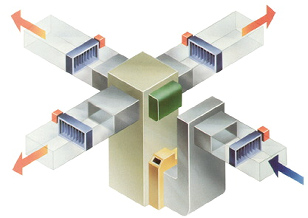
So how does it all work? How does your hvac system know to put cooling upstairs,
and heating downstairs? First, let's look at what makes up a zone system. Residential
zone systems are made up of a zone controller, electrically controlled dampers,
and zone sensors (or thermostats). Once your contractor has determined which sections
of your home are to be zoned, dampers are installed in your ductwork. In some cases,
your existing ductwork can be used as is; for the most part, however, portions of
your ductwork will need to be rebuilt to handle the requirements of zoning. Of course,
if your home is just being built your contractor can easily install the ductwork
in a "zone friendly" manner. After installing the dampers, thermostats
are installed in each zone. Next comes the zone controller, the "brains"
of your zone system. All the dampers and thermostats are wired into your zone controller,
and your zone controller is then connected to your homes heating and cooling system.
From this point, the zone controller takes over. The controller receives input from
each zone, determines which dampers to open/close, and then begins to operate your
home's heating and cooling system.
Let's take our classic example of the 2 story home. We'll call the downstairs
Zone 1 and the upstairs Zone 2. Your contractor has correctly installed your new
zoning system, and it's time for a test run. You set the Zone 2 thermostat to
call for cooling, and turn the Zone 1 thermostat off for now. The zone controller
- Closes all dampers to Zone 1
- Opens all dampers to Zone 2
- Sends a signal to your A/C system to start up
Your upstairs is now receiving all the cooling power of your system - your zone
controller has determined that Zone 1 needs no cooling, so all airflow is being
directed to Zone 2.
Now let's switch the Zone 1 thermostat to call for cooling as well. Since your
hvac system is already cooling the upstairs, the zone system simply opens the dampers
to allow airflow to Zone 1.
Now let's throw the zone controller a curve ball. Let's set Zone 1 (the
downstairs) to call for heating, while leaving Zone 2 (the upstairs) to call for
cooling - not an uncommon scenario during those "change of seasons" times.
How does the zone controller handle this?
Unlike commercial VAV systems, your zone system cannot operate heating and cooling
at the same time. What happens is this: the zone that first calls for heating or
cooling is given a certain amount of time to reach the desired setpoint, at which
time the zone controller shuts down the first zone, purges the duct system by operating
the fan for a few minutes, then switching over to the second zone's needs. In
our example above, let's say that the downstairs system comes on first, calling
for heating. The zone system cycles the dampers and turns on the home's heating
system. At some point in the heating cycle, however, Zone 2 comes on, calling for
cooling upstairs. The zone controller allows the heat to continue running downstairs
for a pre-determined time (normally about 7 minutes) OR until the desired temperature
is reached downstairs. When either of these conditions occur, the zone controller
then
- Shuts off the heating system
- Purges the duct system
- Cycles the dampers to direct airflow upstairs
- Turns on the home's cooling system
Indoor air quality is nothing to sneeze at anymore ... okay, bad pun, but our industry
is finally starting to realize the role it plays in the overall comfort and "live-ability"
of your home. We are realizing that we can do a better job at removing dust, dirt,
mold, mildew, microbes and other impurities in the air.
The key to any IAQ program is maintenance. Regular filter changes or cleaning are
important. Duct inspections are important, too - ductwork that is leaking or improperly
sealed can pull unfiltered outdoor air into your home. One of the biggest problems
with air conditioning systems is standing water in the evaporator's drain system.
Your air conditioner's evaporator system is a perfect breeding ground for mold,
mildew, and other nasties that can affect your health. Only through regular maintenance
can you be sure that your drain systems are operating properly. Call us today to
schedule your IAQ checkup.
The heart of any IAQ program is your filtration system. Several types of filtration
systems are available to consumers other than the standard fiberglass throwaway
filters:
Electronic Air Cleaners
EAC devices use some form of electronic "grid" to trap and eliminate dust,
dirt, and other particulate matter. Often this is in the form a cross pattern of
charged wires known as a "grid". EACs can trap eliminate particles as
small as 1 micron, but do little to eliminate odors or non-airborne matter. EACs
are installed in your home's duct system just before the furnace. EACs require
annual maintenance (in some circumstances, this may be required more often), and
this maintenance is not something the average homeowner can perform.
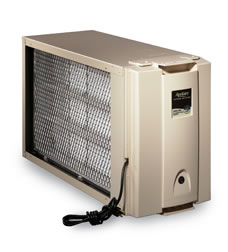
Electrostatic Filters
These filters are non-powered, and work by combining several layers of materials
to form the filter. Most contain at least one layer of activated charcoal for odor
control, and several layers of different materials to generate a small static charge
when air is passed over them. This static charge is what attracts airborne particulate
matter. These filters are washable and easy for the average homeowner to maintain
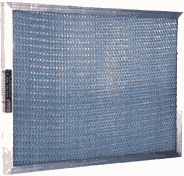
Media Filters
Media filters are relatively new to the HVAC world. They are basically large, thick
pleated filters (4 - 5" thick), made from paper or some synthetic medium. These
are somewhat dense, but since they have such a large surface area, they don't
restrict airflow like some 1" air filters. These are non-powered filters, and
are installed in your duct system (normally just before your furnace) and are changed
generally once a year. The replacement media can be fairly expensive ($30 - $60)
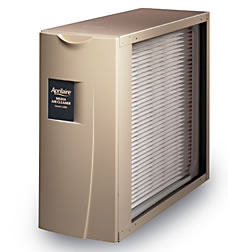
Ultraviolet Lights
Filtration is important, but we've gone beyond that. We can now outfit you system
with ultraviolet lights to kill microbes. These systems are effective in keeping
down the presence of microbes, but only in the areas where the light is illuminating
the area. Typically, you'd install a ultraviolet light near the evaporator coil,
since this is where most microbes tend to collect. Note that UV lights do NOT keep
ductwork clean, as some suggest; they simply kill microbes in the areas directly
illuminated by them. UV lights must be handled very carefully and installed correctly;
installation and maintenance is generally not something which can be performed by
a homeowner.
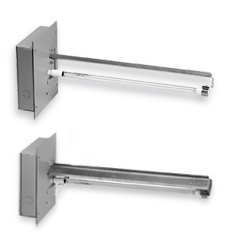
Ventilation
One area often overlooked when dealing with IAQ is ventilation. New homes today
are very tightly constructed, with tight fitting windows and doors, sealants - even
"whole house blankets" that wrap the home in a layer of plastic. While
this is great for energy efficiency, it doesn't allow the home to "breathe".
Indoor air can become stale and polluted, and over time can become a health hazard.
The answer: Whole House Ventilation. Ventilation can be as simple as opening a window
or door, but often that's not the best solution when the temperatures get extreme.
The solution? Let us install an Energy Recovery Ventilator in your home. An ERV
allows us to tailor exactly how much air we bring into your home, and special construction
of the ERV allows us to warm or cool the incoming air, which means you don't
lose those dollars you spent heating or cooling!
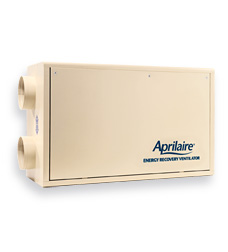
Humidifiers and Dehumidifiers
Your home's air conditioning system doesn't just cool the air - it also
removes humidity. When we talk of "latent" versus "sensible"
heat, we're basically talking about the addition of humidity: Sensible heat
is basically the temperature that we humans "sense", which is a combination
of the actual ambient temperature correlated with the humidity level. If we can
control the moisture content in our home, we can make our living space much more
comfortable, and keep our air fresher and cleaner.
In our southern regions we have summer humidity, and lots of it. Often your home's
a/c system just can't keep up with the demands (and in the Fall and Spring months,
you don't want to run your air conditioner only for humidity control) and you
end up with a house that's cool but clammy. That's not good for your comfort
or for your indoor air quality. When humidity levels are too high - above 50% -
mold and mildew flourish. There is no practical way to eliminate all mold and mildew
from your home, but you can reduce the conditions which cause those spores to grow
- and that means reducing the moisture level in your house. The answer is a whole
house de-humidifier. These work by sensing your home's humidity levels and operating
the furnace's blower system when conditions get our of range. These are installed
next to your furnace, and are attached to your home's existing duct system.
Some even come with optional fresh air intakes
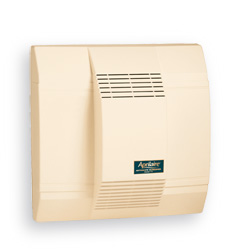
While too much humidity can be a problem, in the winter months when our heating
systems are operating we're often faced with the opposite - not enough humidity.
Often our home's humidity levels can drop as low as 10% in the winter, and that's
not good for people with breathing difficulties, and many experts agree that while
mold and mildew don't like low humidity levels, viruses do. Dry noses, cracked,
itchy skin, static shock, warped woodwork and moldings - all of these are
signs that your home's humidity level is too low. What can you do? Install
a whole-house humidifier. These systems install in your home's duct system,
and operation in conjunction with your furnace and blower system. These systems
sense the moisture level in your home and automatically add water vapor to your
heating system. Most high quality systems use a "water panel", a porous
surface that is saturated with water. Air from your furnace passes over these panels
and pick up water vapor. Beware of the "atomizing" style of humidifiers.
They do little more than spray a mist of water into your duct system, are prone
to failure, and can cause severe water damage when they clog up.
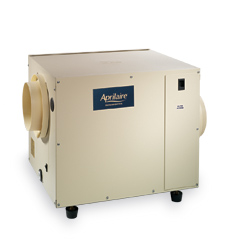
As fuel prices rise, the need to more concisely control our home's heating and
cooling has become more important. Older bimetal thermostats work okay, but they're
prone to calibration errors and can have large temperature swings - neither of which
are going to help you save on you home's energy use.
Enter the world of microelectronics. Today's digital thermostats use sophisticated
technology to monitor the temperature in your home, providing you with more precise
temperature controls. With a digital thermostat, the setting you choose is the setting
you maintain - there is no more "dead band", and no more temperature swing.
Digital thermostats are extremely accurate, and that results in lower power consumption
for you.
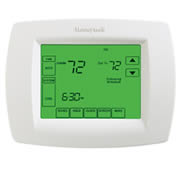
There's another breed of digital thermostats as well - the programmables. A
programmable thermostat allows you to control your home's temperature based
on time periods. For example, in the summer you may wish to raise your home's
temperature when everyone has left for the day, but have the temperature return
to a comfortable setting by the time you get home. A programmable allows you to
do this by storing "set points" and "periods". A "period"
is simply a window of time - for example, 8:00 a.m. to 5:00 p.m. During that time,
you may wish to raise your temperature up to 80 degrees. After all, if no one is
home, there's little reason to keep the home in the normal human comfort zones.
Programmable thermostats come in different varieties. The top level units have touch
screen settings, and can program dozens of periods for a particular day. Some of
these can even interface with your home's computer system, allowing you to monitor
and adjust your home's comfort level from any internet-connected computer.
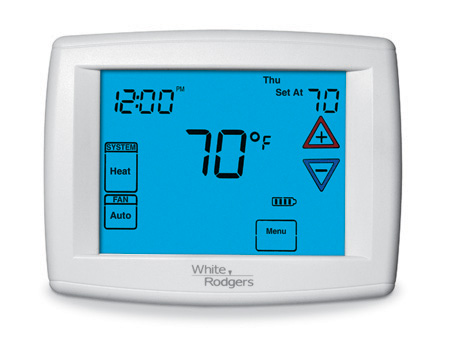
But if you want the mack-daddy, gotta-have-it, my-stuff-is-better-than-your-stuff
thermostat, then look no fruther than
Trane's Comfort Link II control

This is a controller, not a thermostat mind you. It does things no other controller
can do, from doing double duty as a picture frame to showing you the current weather
conditions (if you have a wireless network in your house, of course). It's a touchscreen
display and can be used with any current HVAC system (with the optional adapter
pack). With a Trane system, it operates as a programmable thermostat, a zone controller,
a statistical display, and as an alert system (it can contact your installing contractor
if a system failure is sensed!). You can access this from a smartphone or your PC,
and you can raise or lower the temperature of your house while on vacation.